
| Wes Boyd's Spearfish Lake Tales Contemporary Mainstream Books and Serials Online |

Havasu Creek, Lava Falls, Angel's Camp (Mile 181)

| Wes Boyd's Spearfish Lake Tales Contemporary Mainstream Books and Serials Online |

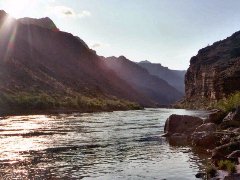 |
|
Upriver from Backeddy in the early morning light. |
I was wakened by the familiar roar of the propane stoves heating water, to discover that it had cleared off and was rather cool. I sat up, pulled on the warm fleece jacket, and commenced with the morning getting around. It was still something of a production, but getting to be a practiced one, now. Usually I tried to have things pretty well packed up by breakfast, but this morning I dawdled a bit, just checking out the awesome beauty of the place in the low, early morning light.
 |
|
Leaving Backeddy campsite on the morning of the sixth day. |
Soon, I wandered down to the kitchen, not far off, to discover that breakfast was omelets, with make your own innards. I only had one, a little light, and could have gone back for seconds, but after seconds the night before I figured I'd better hold off a little. I sat eating and drinking coffee, staring at the scenery some more. Not far around the cliff from the camp was another set of Anzani granaries, located in a slot between two layers of rock, but easily accessible from camp. Several people had wandered over to investigate them the night before.
As always, we were a while getting around, made worse by the fact that people had scattered all over the place on this large camping area. Getting set to head out on the river, I put on my rain gear again, more to stave off the cool than anything else, figuring that I could take it off again when I got warm, which would hard to do if I kept wearing the polypro. It turned out to be just as well; shortly after leaving camp, we headed into a narrow section of Canyon that Joe said the river guides called the "Icebox". It's narrow enough that not much sun gets down there, and it's fairly cool, even on the hot days of the summer. Joe said that in the summer the trip days tend to work out that they run the place in the morning, and when you're used to 100 degree temperatures, it's really uncomfortably cold.
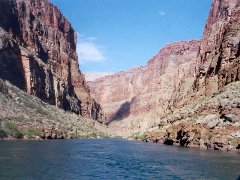 |
|
Heading into the "Icebox". |
It was uncomfortably cold this morning, as well, almost chilly, sitting out on top of the raft where the breeze and the motor wind could get at us. Most of the rapids this morning were small and not particularly remarkable, and we mostly stayed dry, which was a blessing, until we got to Upset Rapid (Mile 150).
This is a pretty big rapid, and, like many on the trip, carries a story with it. Back in the seventies, Joe told us, a Hatch trip was running it in "snout boats", a smaller, catamaranish looking boat -- and, in those days, the design wasn't as well developed, and the motor was mounted on the stern with a motor board held on by a confusing array of ropes and straps. One of the boatmen -- I missed the name -- was well-known for his talent at making pies down in the canyon, but in Upset, the snout boat overturned, and the boatman was caught by his PFD in the motor mount and drowned. The Hatch crew, in his memory, stuck a pie plate to the wall nearby in his memory. The Park Service, trying to keep such intrusions out of the Canyon, took it down, but the next Hatch trip through stuck up a replacement. For years, the Park Service would tear the pie plates down, but the Hatch boatmen kept putting them back up again, until finally, for once, the bureaucracy gave in. The current pie plate has only been there a couple years -- its predecessor had washed away -- but the Hatch crews, keeping to tradition, put up a replacement, which was now rusty against the rock.
 |
|
Looking back at Josh's raft as we head through the "Icebox". |
Upset was a rather challenging rapid, but here, Joe had cooked up something. In many rapids, we were the first boat through, and we'd turn around in the eddy below, so Jason could get a picture of Josh's raft running it. In normal circumstances, it would be hard to tell the boats apart, at least Joe had told Josh, but Josh's big white cowboy hat stuck out like a sore thumb. Josh wasn't particularly interested in running a "9" rapid without his lucky hat on, so Joe suggested that above the rapid, they briefly exchange boats. "Well, all right," Josh agreed, "Just don't hurt my boat." So, above the rapids, we came together, and the boatmen switched, and we ran Upset with Josh at the helm. We pulled out in the eddy, and Jason climbed up onto the boatman's box, video camera in hand, and waved at Joe to start his run. Joe waved back, gunned the engine, spun the raft around, and calmly ran the rapids backwards, bouncing off a wall in the process! I hope Jason didn't have his audio on, or it was going to be filled with Josh's muttered curses about not screwing up his boat.
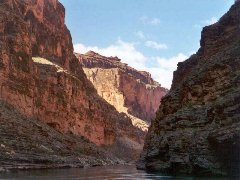 |
|
Deep in the "Icebox," which doesn't get much sun, and the shadows are deep. |
We ran on for a couple miles, Josh still running the boat, and Joe staying away from us -- I presume to give the fuming Josh a chance to cool off before switching back. We ran on for another few miles, noting that the Utah agave had given way to a different cactus, the spindly, multi-branched ocotillo. As always, there was the kalideoscope of the Canyon, ever changing, chaotic, but like any chaotic system, showing an order at some level. There was always the background vision of the layers of the sedimentary rock, showing at some level wherever you turned, but broken by side canyons, washes and draws, all filled with rocks and rubble, here and there talus slopes below a break in the rock above, clearly showing how they had washed down from a higher level, ever constant, ever changing -- and ever, a challenge for the photographically oriented.
Soon, we reached Havasu Creek (Mile 157). This, we knew, is a popular stop on the river, and a difficult place to tie up -- in fact, the motor rigs usually tie up with one side to a wall in the middle of Havasu Rapid, but as we swept around the bend, it appeared crowded -- and it was; we could see that every possible tieup along that wall was filled, with the three Hatch motor rigs we'd met yesterday, with the two Grand Canyon Explorations motor rigs we'd played tag with since day one, and the one from Diamond River that we'd also frequently met. The mouth of Havasu Creek was filled with several oar boats, from Outdoors Unlimited, and if we were going to land there it was going to be tricky. Joe and Josh nosed the rafts onto a small beach just upstream of the creek on the far side of the river, and Joe hopped out and worked his way up a small cliff, climbing like a mountain goat, until he could get a good view of the situation. These young guys hop around the boats and rafts with impunity, while we old coots have to watch our step and envy them their youth. We could watch Joe scratch his beard and hear him thinking -- "Indecision is the key to flexibility" -- and finally, he worked his way down the cliff. "Might as well go in the mouth," he told Josh and the rest of us.
"Pretty shallow in there," Josh opined.
 |
|
Moored for a hike in the mouth of the popular Havasu Creek. |
"Should be all right," Joe replied, and proceeded to show Josh how. He motored the raft across the river, spun it just above the lip of the rapids, put the bow onto the rocks, and spun the raft again, keeping the most of the boat over the shallow stuff but the motor out into the narrow deeper part, then backed up for a landing, occasionally having to swing the motor around to scunch to raft sideways. He came to a stop with the creek partly blocked, and yelled over to a boatman from the oar boat party, left behind to watch the rafts, "How long are you going to be here?"
"Till about three," the girl yelled back. "They're going up to Beaver Falls."
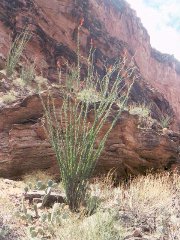 |
|
Ocotillo Cactus at Havasu Creek. These replace the Utah Agaves as you get downriver. |
"OK, we'll be gone by then," Joe told her, and signaled for Josh to follow him into the creek mouth. When the whole evolution was completed, our rafts were moored side to side, front to back, and we climbed out onto the hard rock of the downstream side of the creek.
The short walk up Havasu Creek was one of the harder hikes I made on the trip, mostly because the alleged "trail" was so poor, and it involved a lot of rock climbing and scrambling. I slid backward, slowly, down one rock, the lousy shoes scrambling for traction, and fell gently backward over another one, trying to keep stuff from coming out of my pockets. We had to wind back and forth over the ledges at the takeout, climbing from one to another, and then headed up into the side canyon. After about a quarter mile, the only way to proceed was to wade the river -- no great trick, but it was strong enough that you could feel the current pushing at you. We went on up the river another quarter mile or so to a pool where the turquoise-colored water, nearly as deep a color as that of the Little Colorado, formed a nice swimming hole. Here, the trail was chest-deep through the water, and I didn't want to get that wet, so I found a shady spot, took a few pictures, and finally decided to walk slowly back down the canyon in search of a shady spot, to get out of the heat a little, drink in the place, and snap a few more photos of the creek.
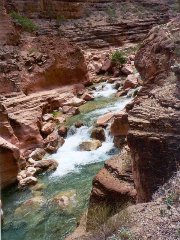 |
|
View up Havasu Creek. |
I took my time getting back, and partway down was overtaken by a bunch of rather wet kids -- I say a bunch, and honestly, I estimate there were about fifty of them, all fifth graders, it turned out, on a class trip with a number of teachers and chaperones. They had hiked down to the campground at Supai Falls the day before, and were on a day hike down to the river. I let them get by me, then took a few more photos, and recrossed the creek to the shady side, still looking for a good place to sit. There seemed to be a good one at the top of one of the harder rock scrambles, and I was just settling into it when I heard Josh yell, "You OK?"
"Fine," I told him, "Just looking for a shady spot."
It turned out that Vance had also gone up on the hike and had twisted an ankle. Josh and four or five others were helping him back down the canyon, but he was obviously in considerable pain and moving slowly. Since they might need more help and I wasn't real sure of the zig-zag route back down the ledges anyway, I decided to tag along. It took a while to get back down to the boats, and while I helped a little, most of the help fell on Josh's strong shoulders, and he did a great job. Down at the boats, someone grabbed one of the folding chairs from the raft, set it in the river, and let Vance soak his aching ankle in the cold water, which I found about the only shady spot around, under a ledge down by the river, trying to work on my notes, but mostly thinking about an incident that had occurred here.
 |
|
Waterfall and pools along Havasu Creek. |
I have mentioned before that Colin Fletcher's "The Man Who Walked Through Time" was one of the books that inspired me to the Grand Canyon. On his hike, forty years before, he had come down to this very spot, trying to see if it would be possible to follow the river bank on his walk upriver. The ledges across the creek didn't look very promising, and, a timid swimmer at best, he had swum with a life jacket across the few feet of creek to get a look around the corner. While upstream of there I had thought that it might be possible to walk a long way, right there at the creek mouth it looked pretty bad, and so he thought. His brief reconnaissance convinced him that the walk there would be impossible -- for which we are grateful, for it led to his decision to make his memorable walk partly along the Esplanade, a miles-long ledge far above the river, some of the best writing about hiking that's ever been set to paper. Fletcher is an old man, now -- he ran the river in a small raft over ten years ago, from the headwaters to the Sea of Cortez, and wrote about it in another memorable book, "River". The memory of this place proved to have stuck with him, and a touch of his spirit seemed to linger here, as well.
Over the next hour, the rest of the group dribbled back. It was warm out, although comfortable in my shady spot close to the rafts, although noisy with all the fifth graders trying to skip stones on the water, so I figured it would still be warm when we got back out on the river. When we got going again, I didn't bother to put the rain suit back on. This proved to be a mistake -- what I hadn't noticed, what none of us had noticed from our warm, protected spot back up the creek, was that the wind had come up, and come up harder than we'd known before, except for the storm in camp the first night. I honestly estimated at 25, gusting to 40, with the wind coming straight up the Canyon and the motor-wind from the rafts added to it, and it was pretty cold and miserable out there. It didn't take me long to change my mind about putting on the rainsuit -- it gave a little wind protection -- although it was difficult in the strong, gusty wind. We ran on a number of miles farther, fortunately through no particularly big rapids, as the sky grew largely overcast, and it got uncomfortably cold. As always, though, whenever the raft hit a wind wave -- and there were places I saw them two feet high -- spray crashed up over the blunt bow, soaking us down. Most of us huddled together at the back of the raft for what protection we could get on what was proving to be a miserable afternoon, although running through memorable scenery -- so much scenery, and so sated by it was I that I actually fell asleep for a spell that afternoon.
What made it even worse was that we knew we were going to get even wetter, for we knew that Joe planned to run Lava Falls before we hit camp. Lava is the biggest rapid on the river, the most storied, the most dangerous, although for a few years there, before a flood altered it somewhat, Crystal gave it a run for the money. For once, I'd be glad to be seeing a big rapid, for this time I knew it would be the announcement that we would soon be off of the river.
The geology of the river had changed here a little, Joe told us. The surrounding sedimentary rock was millions of years old, but less than a million years ago a number of volcanos had spewed lava into the canyon, in places visibly overrunning the sedimentary rock, giving testimony to its age. The lava is hard and black, and isn't cut by the river easily.
 |
|
Josh's raft running Lava Falls in a shower of cold, wet spray. |
Finally, after what seemed to be an eternity, we reached Vulcan's Anvil (Mile 178), a mile above Lava. Vulcan's Anvil is a core of an ancient volcano, much worn down, but it gives notice that Lava Falls is not far away. Before long, we could hear the roar, see the plunging water. Joe had planned on stopping to scout the rapids, but knew pretty well that the party was wet, tired, cold and cranky, so decided to run it without scouting in order to get off the river that much more quickly. I'm glad he did, in a way -- it left little time to get nervous. With only a little pause for a "boat scout" we plunged over the lip of the rapid, down the tongue, and into a seething cauldron of backrollers and whitewater, green water coming on board, making us even colder and wetter. In only a moment, we were in an eddy on river left, and Jason, ever eager for photos, was up on the boatman's box with the video camera to record Josh's run. In a minute or two, Josh ran it cleanly -- well, fairly cleanly, in that he didn't hit anything, but like us he took a lot of water over the bow of the raft, although, from where I sat, it looked like he'd made a drier run than we had, as usual.
Glad to have Lava behind us, and knowing we would soon be in camp, we ran down through Lower Lava Rapid without hardly noticing it. Upriver, this would have been one to be concerned with, but now it seemed but minor in comparison.
Back up at Havasu, Joe had coordinated with the leaders of the other raft parties -- they tend to know each other well, and many of them live in Flagstaff, as he did -- so we wouldn't be heading for the same camp, but that didn't mean that a private party or others might not be staying in the campground where he wanted to go. As it worked out, though, the beach at Angel's Camp, a mile below Lava, was empty, and he lost no time in heading the rafts into it. Having the sand under my feet felt pretty good that afternoon.
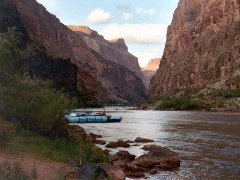 |
|
Angel's Camp, below Lava Falls, where we stayed the sixth night out. |
As always, I headed off to find a place to camp. I wanted to find a place away from the main camp, and out of the wind, which was a little harder. Although pretty overcast, there were breaks in the clouds, and I could see that they were cumulus so would likely break up before the evening was over with, so decided to sleep out again. I finally found a likely spot, on the far side of a small dry wash, in the wind shadow of a tight bunch of tamarisks, perhaps a hundred yards downstream of the kitchen, but only reachable by a clamber up through some rocks. I wasted little time getting out of my wet clothes and into the warm polypro and fleece, hung my wet stuff up on the many available branches to dry in the strong, dry wind, inflated the Paco pad, then just lay back on my back, staring at the sky, trying to unwind.
Dinner was lasagna that night, and one of the best I've ever had, but this day, like all days, had been full from sunrise to sunset. I was tired, and wasted little time after it started to get dark in heading for the warmth of the sleeping bag, as the wind blew the branches of the tamarisks around above me.




